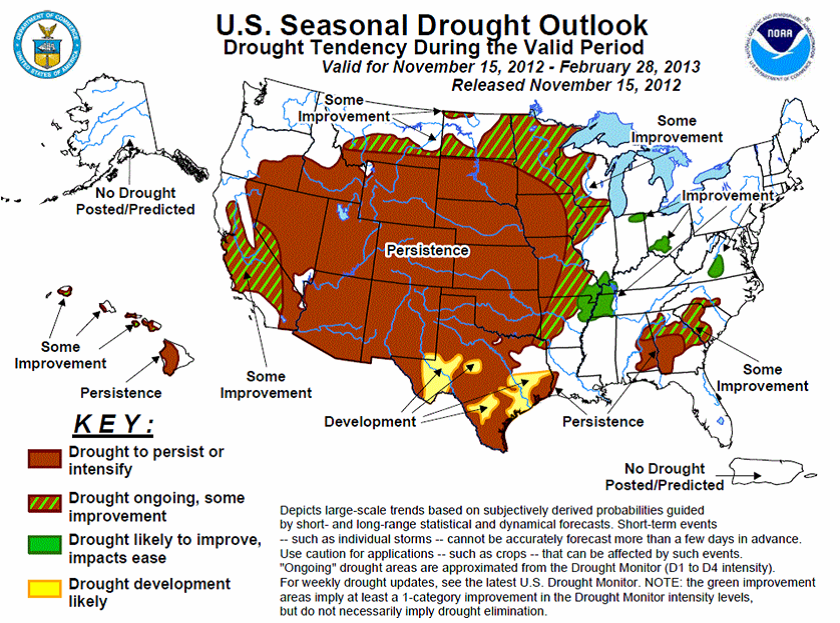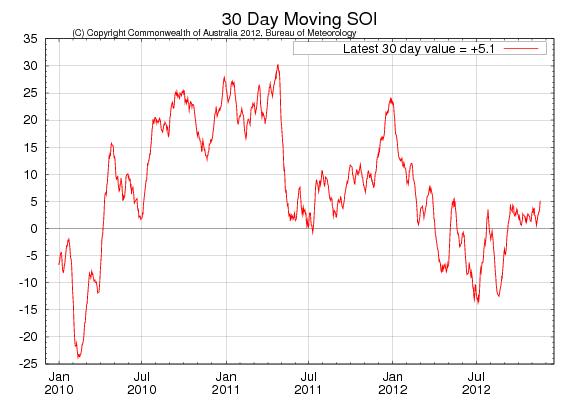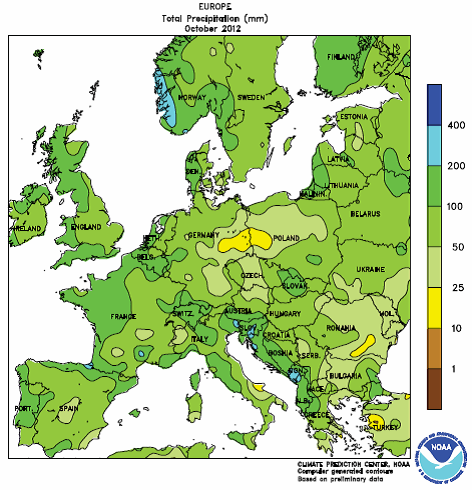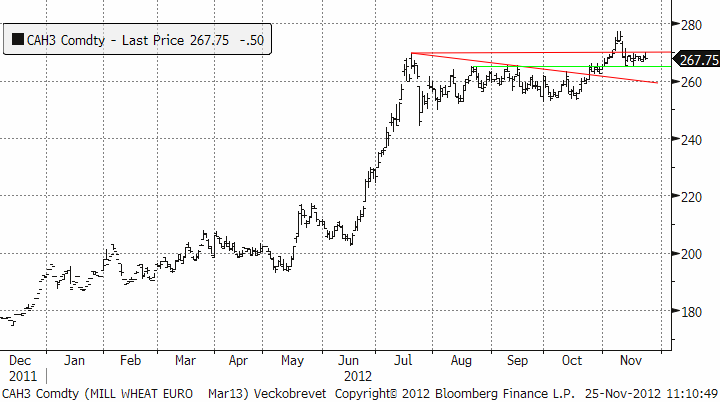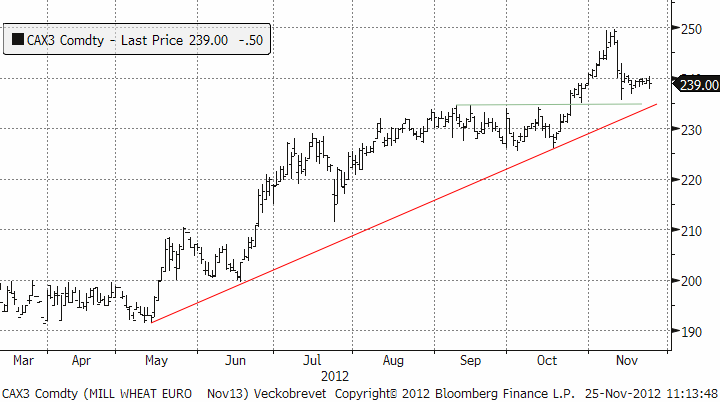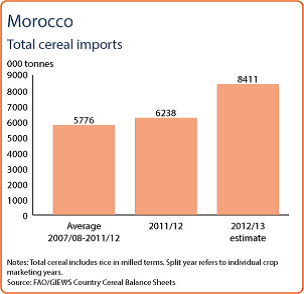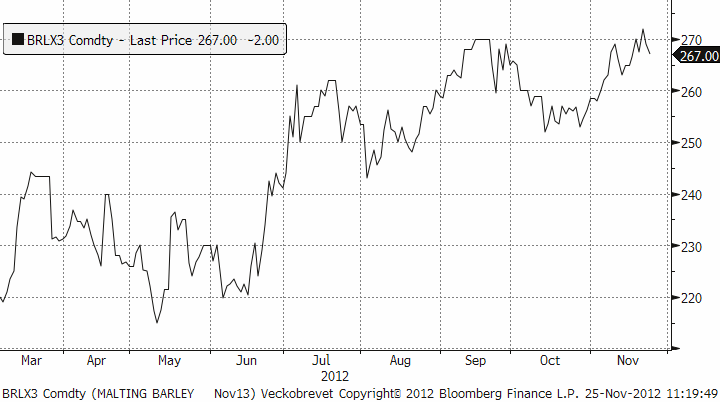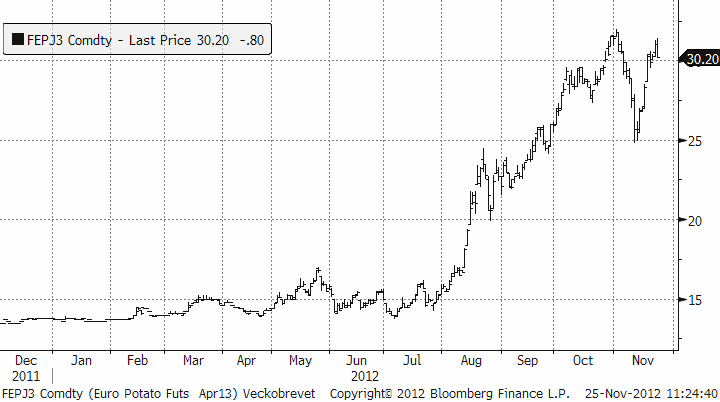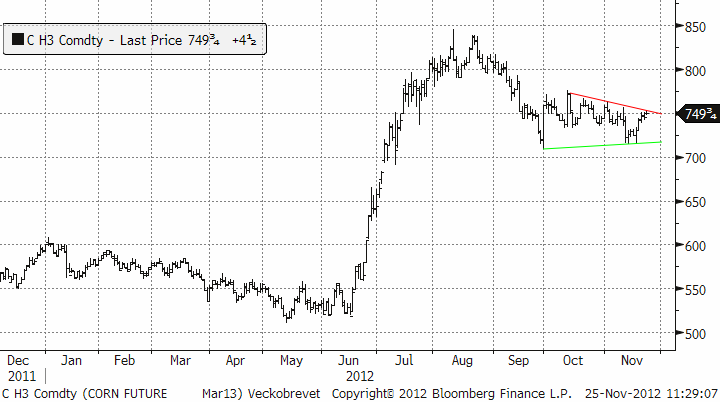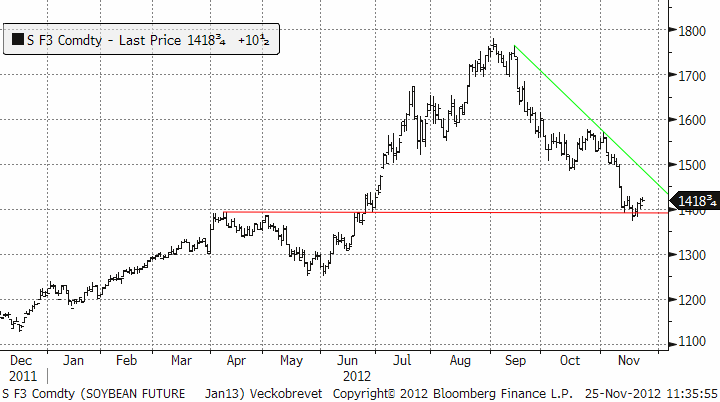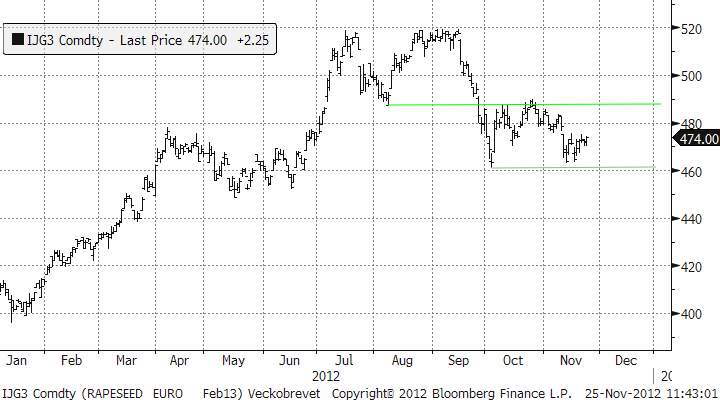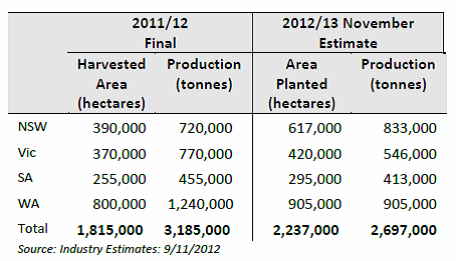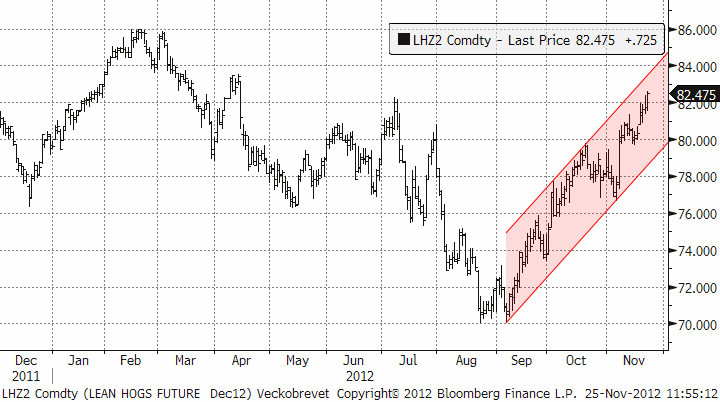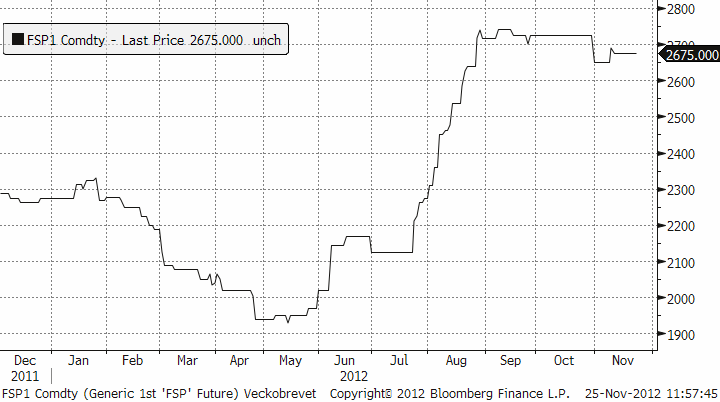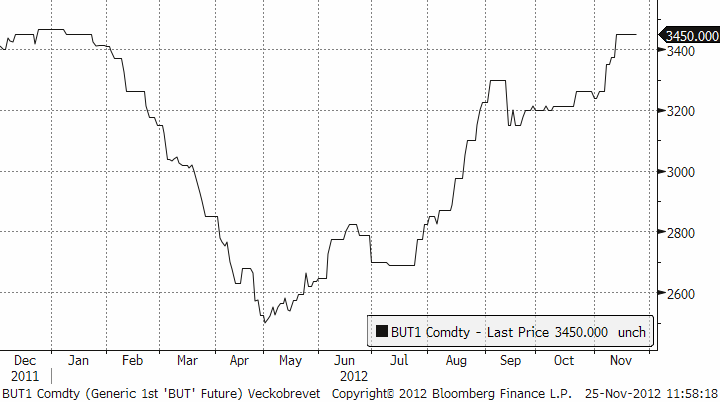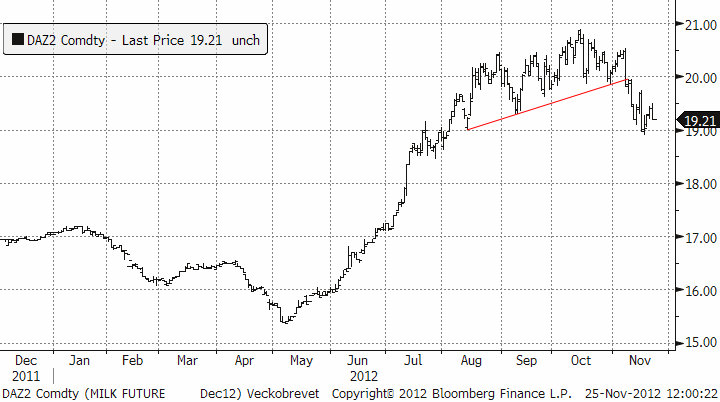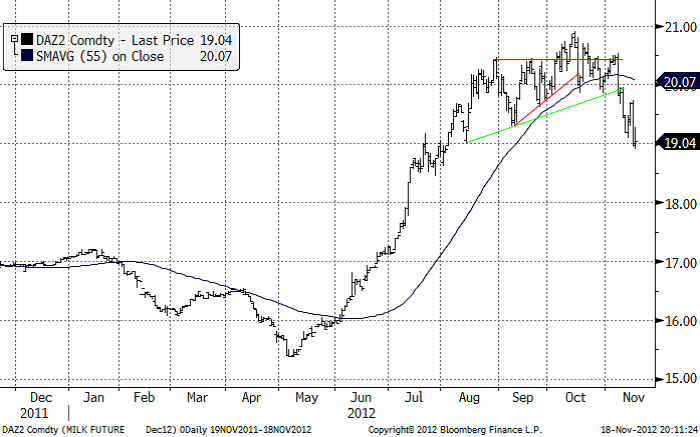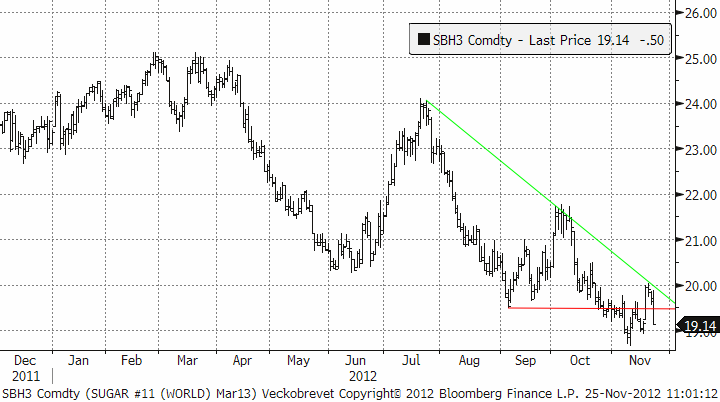Analys
SEB Jordbruksprodukter, 26 november 2012
 Veckan har varit relativt lugn på marknaden för jordbruksprodukter inför Thanksgiving-helgen i USA, med den amerikanska börsen CBOT stängd under torsdagen och halvdag under fredagen.
Veckan har varit relativt lugn på marknaden för jordbruksprodukter inför Thanksgiving-helgen i USA, med den amerikanska börsen CBOT stängd under torsdagen och halvdag under fredagen.
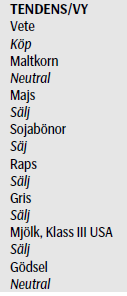 De makroekonomiska problemen i Europa, som vi nämnde i förra brevet, blev ännu tydligare efter Moodys beslut att sänka Frankrikes rating från högsta betyg – vilket visar på den ökade oron för Eurozonens näst största ekonomi. Turerna kring utbetalningar till Grekland fortsätter då Eurozonens finansministrar återigen misslyckats med att komma överens, USA brottas med det finanspolitiska stupet (fiscal cliff) och spänningarna i Mellanöstern ökar. SEB fortsätter, att som första bank i världen, erbjuda sina kunder att prissäkra ett börsbaserat mjölkpris i kronor per kilo, i poster om 10,000 kg.
De makroekonomiska problemen i Europa, som vi nämnde i förra brevet, blev ännu tydligare efter Moodys beslut att sänka Frankrikes rating från högsta betyg – vilket visar på den ökade oron för Eurozonens näst största ekonomi. Turerna kring utbetalningar till Grekland fortsätter då Eurozonens finansministrar återigen misslyckats med att komma överens, USA brottas med det finanspolitiska stupet (fiscal cliff) och spänningarna i Mellanöstern ökar. SEB fortsätter, att som första bank i världen, erbjuda sina kunder att prissäkra ett börsbaserat mjölkpris i kronor per kilo, i poster om 10,000 kg.
Odlingsväder
Väderförhållandena är fortfarande ett problem i USA och i södra Ryssland som båda lider av underskott vad gäller nederbörd. I Argentina fortsätter sådden att försenas av alltför mycket nederbörd. I Brasilien lider de södra delarna av torka medan andra stora produktionsområden, t.ex Mato Grosso, gynnas av goda väderförhållanden. U.S. Climate Prediction Center uppskattar att torkan i USA, som bl.a påverkar tillståndet för det amerikanska höstvetet nu, kommer att fortsätta långt in i februari.
Den senaste rapporten från Australia Bureau of Meteorology visar att ENSO ligger kvar på en neutral nivå och att det nuvarande neutrala mönstret sannolikt kommer att bestå åtminstone fram till slutet av året.
Även om temperaturerna i Stilla havet ligger under El Niño nivåer, så är de fortfarande över genomsnittet. Southern Oscillation Index (SOI) har hållit sig inom neutrala värden under de senaste två veckorna, och den senaste noteringen ligger nu på +5.1.
Under oktober månad har ihållande regn över Storbritannien och norra Frankrike försenat skörden och hämmat sådden av höstgrödor. Enligt FranceAgrimer var sådden av vete (mjukt) avklarad till 88% per den 12 nov, att jämföra med 98% vid denna tid året innan. Även Spanien och Italien har fått mycket nederbörd, som dels har varit behövligt för att återställa markfuktigheten, men som även har orsakat stora översvämningar – framförallt i norra Italien. Även Sverige har påverkats av regnet, med en minskad höstsådd i framförallt Halland och Mellansverige.
Vete
Nedan ser vi kursdiagrammet för marskontraktet på Matif. Priset har fortsatt sidledes under veckan. Den tekniska analysen kvarstår från förra veckan. ”Priset har rekylerat ner till ett smalt område mellan 265 och 270 euro per ton – motståndslinje ovanför och stöd precis under.
Vi tror att priset kommer att stiga i mars-kontraktet, snarare än falla. Till stöd för detta tar vi novemberkontraktet 2013, som vi ser i kursdiagrammet nedan. Där finns ingen tydlig motståndsnivå på uppsidan, däremot ett starkt stöd som ligger på 235 euro. Vi ser att rekylen från 250 euro har hejdats av stödet. Efter sedvanlig ”sidledes” rörelse för att ta kraften av rekylen, tror vi det är sannolikt att priset gör ett nytt försök uppåt.”
Måndagens Crop Progress från USDA visar att höstvetets uppkomst i de 18 stater som rapporterar ligger på 84%, vilket i stort sett är i linje med det femåriga genomsnittet på 86% vid denna tid. Det torra vädret kvarstår och tillståndet för USA’s höstvete fortsätter att försämras, där endast 34% är klassat som ”good/excellent” nu, vilket är 2% lägre än förra veckan och betydligt lägre än förra årets 50% vid denna tid. Grödor klassade som ”very poor/poor” har ökat med 2% sedan förra veckan och i South Dakota tillhörde 60% denna kategori. Det dåliga skicket på grödorna gör också att de blir mer sårbara för utvintring och rikligt nederbörd över the Plains kommer att vara avgörande i vår för att förhindrabetydande problem och minskad avkastning.
Spannmålsproduktionen i Marocko 2012 uppskattas till 5.3 mt av FAO, en minskning med 38% jämfört med förra årets exceptionella skörd och 23% under det femåriga genomsnittet. Sen sådd av grödor, köldperioder i början av året och därefter torka har bidragit till nedgången i produktionen. Produktionen av vete 2012 förväntas minska från 6.02 mt till 3.87 mt. Importen av spannmål förväntas därmed att öka med 35% under 2012/13 till rekordhöga 8.4 mt, varav 5.2 mt vete. Sådden av höstgrödor (framförallt vete och korn) pågår nu för fullt, och trots att ansenliga mängder nederbörd har saktat ned fältaktiviteten så har markfuktigheten förbättrats avsevärt och därmed gett möjlighet till en tidigare sådd.
Det ryska jordbruksministeriet har höjt sin prognos för landets export av spannmål 2012/13 (juli-juni) från 10-11 mt till 15.5 mt, med hänvisning till att 11 mt – inklusive 8.5 mt vete – redan har exporterats, och utan några avsikter att införa restriktioner. Om exporten skulle komma att uppgå till 15.5 mt eller mer uppskattas ingående lager 2013/14 att hamna på kritiska nivåer (6 mt). Prognosen för sådd av höstgrödor justeras ned till 15.9 miljoner hektar från tidigare 16.82 milj/ha på grund av ogynnsamt väder, Rysslands Grain Union uppskattar exporten av vete till 9.5-10 mt, vilket är i linje med USDA’s estimat på 10 mt i senaste WASDE-rapporten.
Frågorna runt ett eventuellt införande av Ukrainas exportstopp på vete kvarstår.
Tidigare i veckan sa Egyptens GASC att de nästa år kommer att ta bort Ukraina från listan över leverantörer av vete, eftersom Ukraina har planer på att stoppa exporten från den 1 december 2012 – något som GASC ska ha fått en officiell bekräftelse på. Från Ukrainas ambassad i Kairo skickades då en formell begäran till GASC om att kvarstå på listan över leverantörer givet att det finns vete tillgängligt för export och från Egyptens sida säger man nu att Ukraina kommer att stå kvar på listan så länge som kontrakterade kvantiteter kommer att levereras även om ett exportförbud införs.
I allt detta så fortsätter Ukraina att säga att ett exportstopp inte är aktuellt. Så här långt har Ukraina exporterat 10.72 mt spannmål, varav 5.17 mt vete. Årets skörd i Ukraina är nu klar, med en veteproduktion på 15.0 mt, vilket är något lägre än USDA’s nuvarande estimat på 15.5 mt. Irak har varit aktiva i marknaden och köpte 350,000 ton vete från Australien (200,000 t), Kanada (100,000 t) och Ryssland (50,000 t). Amerikanskt vete fanns med bland anbuden men ligger fortfarande för högt i pris.
Sverige
Preliminära uppgifter på riksnivå från Jordbruksverket för 2012 visar att Sveriges totalskörd av spannmål beräknas uppgå till 5.1 mt, en ökning med 10% från 2011 och 4% högre än genomsnittet för de senaste fem åren. Totalskörden av höstvete beräknas preliminärt att uppgå till närmare 2 mt (38% av den totala spannmålsskörden) och trots att höstvetearealen minskade jämfört med förra året så är totalskörden i nivå med förra årets skörd eftersom hektarskörden ökade med drygt 20% jämfört med 2011.
Maltkorn
November 2013-kontraktet har testat motståndet vid 270, men föll tillbaka. 270 verkar vara ett starkt motstånd.
Potatis
Potatispriset som tidigare fann stöd på 25 euro per deciton, har fortsatt att stiga och noterar nu ett motstånd vid 31 eur.
Majs
Majspriset (mars 2013) har vid två tillfällen nu hållit stödet 709 cent per ton, och testar nu istället motståndsnivån kring 750. Ett genombrott av den nivån kan innebära ytterligare test för högre nivåer, och om det sker bör man överväga att minska korta exponeringar, och vänta in nya säljlägen.
Safras e Mercados senaste rapport visar att sådden av majs i Brasilien nu är avklarad till 81% och produktionen av majs 2012/13 förväntas uppgå till 68.969 mt, jämfört med 2011/12 års produktion på 72.336 mt.
Sådden av majs i Argentina går fortsatt framåt om än långsamt. 55% av sådden är nu avklarad, att jämföra med förra årets 68% vid den här tiden. Cordonnier uppskattar produktionen 2012/13 i Brasilien och Argentina till 72 mt respektive 22.5 mt, jämfört med USDA’s prognos på 70 mt respektive 28 mt.
I Ukraina är skörden av majs avklarad till 89% och den totala skörden beräknas uppgå till ca 20 mt, strax under USDA’s estimat på 21 mt. Majs kommer att bli den stora exportvaran från och med nu, och exporten uppskattas till 12 mt.
Sojabönor
Efter att ha konsoliderat i veckan som gick, slutade veckan med en uppåtrekyl i januarikontraktet. Stängningen signalerar en fortsatt rekyl uppåt som bör möta starkt motstånd vid motståndslinjen (se nedan). Vi fortsätter att rekommendera en kort position (såld) i sojabönor.
Enligt Safras e Mercado är nu sådden av sojabönor i Brasilien avklarad till 66% jämfört med 54% förra veckan. Produktionen för 2012/13 beräknas öka med nästan 22% till 82.47 mt, från 2011/12 års 67.76 mt.
Sådden av sojabönor i Argentina avklarad till 31% jämfört med 18% förra veckan. Produktionen estimeras till 57.42 mt, en ökning från 2011/12 års 41.0 mt.
Den totala produktionen i Sydamerika 2012/13 uppskattas till 152.98 mt, upp från 2011/12 års 117.036 mt, med följande prognoser för övriga länder (med 2011/12 inom parentes):
Paraguay 8.64 mt (4.30 mt), Bolivia 2.56 mt (2.38 mt) och Uruguay 1.9 mt (1.6 mt)
Cordonnier uppskattar produktionen 2012/13 i Brasilien och Argentina till 80 mt respektive 55.0 mt.
Oil World justerar ned sin prognos för produktionen av sojabönor 2013 i Argentina och Brasilien med totalt 3 mt, till följd av ogynnsamt väder som har påverkat sådden i de bägge länderna – torka i delar av Brasilien och alltför mycket regn i delar av Argentina. Estimatet för Argentina uppgår nu till 54 mt, mot det tidigare estimatet för en månad sedan på 56 mt, vilket dock är betydligt högre än de 40.5 mt som landet skördade i början av 2012. Prognosen för Brasiliens produktion uppgår nu till 81 mt, en nedjustering från oktobers 81 mt, men fortfarande en bra bit över skörden i början av 2012 på 66.8 mt.
Raps
Rapspriset (februari 2013) handlas i ett brett intervall 460-490 och befinner sig i mitten. Marknaden strävar mot stödnivån och vi rekommenderar fortfarande en kort position. Får vi ett brott nedåt av 460- nivån, bör man sälja ännu mer.
AOF (Australian Oilseeds Federation) säger att utsikterna är goda för ytterligare en stor canola skörd under 2012 nu när skörden drar igång, och uppskattar produktionen av canola 2012/13 till 2.697 mt, jämfört med 3.185 mt 2011/12. Men med en prognos på nästan 2.7 mt så kommer det att bli den näst största rapsskörden, endast överträffad av skörden året innan. Storleken på skörden kommer att påverkas mer av hektar än avkastning, som förväntas uppgå till 2.37 miljoner hektar sådd areal, en ökning från det tidigare rekordet med 23%, medan avkastningen estimeras till ett genomsnitt på 1.2 t/ha – vilket är lägre än det femåriga genomsnittet på 1.5 t/ha.
Preliminära uppgifter på riksnivå från Jordbruksverket för 2012 visar att Sveriges totalskörd av raps och rybs uppskattas till 325 400 ton, vilket är en ökning med 30% jämfört med förra året och den högsta totalskörden på 19 år. Hektarskörden beräknas till 3.75 t/ha, vilket är det högsta som hittills redovisats på riksnivå. Odlingen av höstraps ökade med 10% och avkastningen med 22% jämfört med 2011. Arealen för vårraps ökade med 23% medan hektarskörden nästan var i nivå med föregående års skördeutfall per hektar.
Gris
Grispriset (Dec 12) har fortsatt upp under den senaste veckan. Priset ligger på höga nivåer, nästan lika höga som i somras och uppgången bör ta slut på de här nivåerna. Gris terminer har en säsongs tendens att stiga efter Thanksgiving helgen, men den trenden borde vara begränsad nu i och med de redan höga nivåerna.
Mjölk
Från EUREX priser på smör och SMP kan vi utläsa att priset för ett kilo mjölk(råvara) nu ligger på 3.55 kr per kilo. Anledning till att priset har sjunkit sedan förra veckans 3.58 kr, trots att priset på mjölpulver och smör är oförändrade, är att den svenska kronan har stärkts mot euron. Priset på mjölkpulver i Nordeuropa är oförändrat sedan förra veckan (2675 euro per ton ).
Nedan ser vi priset på smör, som också är oförändrat sedan förra veckans notering på 3450 euro per ton.
Det börsbaserade priset i svenska kronor beräknas med formeln:
där
BUT = priset på smör i euro per ton
SMP = priset på skummjölkspulver i euro per ton
FX = växelkursen för EURSEK.
Precis som vi skrev i förra veckans brev så fann priset på Klass 3 mjölk, på den amerikanska börsen CME i Chicago, tekniskt stöd på 19 cent per pund och rekylerade uppåt därifrån. Trenden är dock nedåtriktad och en rekyl uppåt tycker vi ska ses som ett säljtillfälle.
Socker
Priset på socker (mars 2013) befinner sig i en stark baissemarknad. I veckan som gått rekylerade priset upp ännu en gång strax över motståndsnivån och vände sedan ner igen. Det mest sannolika tycker vi är att priset faller och söker en ny bottennotering.
Gödsel
Januari kontraktet för Yuzhnyy som fann en stödnivå på 365 $ / ton i förra veckan har fortsatt uppåt denna vecka och noteras nu på 376.50 $ / ton.
EURSEK
EURSEK föll i veckan som gick, precis som vi förutspådde i förra veckans veckobrev. Vi tror fortsättningsvis på en ”sidledes” eller fallande kurs.
USDSEK
Genombrottet av USDSEK som vi skrev i förra veckan fick inte den väntade följdrörelsen. Kronan är stark och när dollarn försvagades i fredags blev fallet stort för usdsek. Stödet kommer nu in kring 6,60.
[box]SEB Veckobrev Jordbruksprodukter är producerat av SEB Merchant Banking och publiceras i samarbete och med tillstånd på Råvarumarknaden.se[/box]
Disclaimer
The information in this document has been compiled by SEB Merchant Banking, a division within Skandinaviska Enskilda Banken AB (publ) (“SEB”).
Opinions contained in this report represent the bank’s present opinion only and are subject to change without notice. All information contained in this report has been compiled in good faith from sources believed to be reliable. However, no representation or warranty, expressed or implied, is made with respect to the completeness or accuracy of its contents and the information is not to be relied upon as authoritative. Anyone considering taking actions based upon the content of this document is urged to base his or her investment decisions upon such investigations as he or she deems necessary. This document is being provided as information only, and no specific actions are being solicited as a result of it; to the extent permitted by law, no liability whatsoever is accepted for any direct or consequential loss arising from use of this document or its contents.
About SEB
SEB is a public company incorporated in Stockholm, Sweden, with limited liability. It is a participant at major Nordic and other European Regulated Markets and Multilateral Trading Facilities (as well as some non-European equivalent markets) for trading in financial instruments, such as markets operated by NASDAQ OMX, NYSE Euronext, London Stock Exchange, Deutsche Börse, Swiss Exchanges, Turquoise and Chi-X. SEB is authorized and regulated by Finansinspektionen in Sweden; it is authorized and subject to limited regulation by the Financial Services Authority for the conduct of designated investment business in the UK, and is subject to the provisions of relevant regulators in all other jurisdictions where SEB conducts operations. SEB Merchant Banking. All rights reserved.
Analys
Tightening fundamentals – bullish inventories from DOE

The latest weekly report from the US DOE showed a substantial drawdown across key petroleum categories, adding more upside potential to the fundamental picture.

Commercial crude inventories (excl. SPR) fell by 5.8 million barrels, bringing total inventories down to 415.1 million barrels. Now sitting 11% below the five-year seasonal norm and placed in the lowest 2015-2022 range (see picture below).
Product inventories also tightened further last week. Gasoline inventories declined by 2.1 million barrels, with reductions seen in both finished gasoline and blending components. Current gasoline levels are about 3% below the five-year average for this time of year.
Among products, the most notable move came in diesel, where inventories dropped by almost 4.1 million barrels, deepening the deficit to around 20% below seasonal norms – continuing to underscore the persistent supply tightness in diesel markets.
The only area of inventory growth was in propane/propylene, which posted a significant 5.1-million-barrel build and now stands 9% above the five-year average.
Total commercial petroleum inventories (crude plus refined products) declined by 4.2 million barrels on the week, reinforcing the overall tightening of US crude and products.


Analys
Bombs to ”ceasefire” in hours – Brent below $70

A classic case of “buy the rumor, sell the news” played out in oil markets, as Brent crude has dropped sharply – down nearly USD 10 per barrel since yesterday evening – following Iran’s retaliatory strike on a U.S. air base in Qatar. The immediate reaction was: “That was it?” The strike followed a carefully calibrated, non-escalatory playbook, avoiding direct threats to energy infrastructure or disruption of shipping through the Strait of Hormuz – thus calming worst-case fears.

After Monday morning’s sharp spike to USD 81.4 per barrel, triggered by the U.S. bombing of Iranian nuclear facilities, oil prices drifted sideways in anticipation of a potential Iranian response. That response came with advance warning and caused limited physical damage. Early this morning, both the U.S. President and Iranian state media announced a ceasefire, effectively placing a lid on the immediate conflict risk – at least for now.
As a result, Brent crude has now fallen by a total of USD 12 from Monday’s peak, currently trading around USD 69 per barrel.
Looking beyond geopolitics, the market will now shift its focus to the upcoming OPEC+ meeting in early July. Saudi Arabia’s decision to increase output earlier this year – despite falling prices – has drawn renewed attention considering recent developments. Some suggest this was a response to U.S. pressure to offset potential Iranian supply losses.
However, consensus is that the move was driven more by internal OPEC+ dynamics. After years of curbing production to support prices, Riyadh had grown frustrated with quota-busting by several members (notably Kazakhstan). With Saudi Arabia cutting up to 2 million barrels per day – roughly 2% of global supply – returns were diminishing, and the risk of losing market share was rising. The production increase is widely seen as an effort to reassert leadership and restore discipline within the group.
That said, the FT recently stated that, the Saudis remain wary of past missteps. In 2018, Riyadh ramped up output at Trump’s request ahead of Iran sanctions, only to see prices collapse when the U.S. granted broad waivers – triggering oversupply. Officials have reportedly made it clear they don’t intend to repeat that mistake.
The recent visit by President Trump to Saudi Arabia, which included agreements on AI, defense, and nuclear cooperation, suggests a broader strategic alignment. This has fueled speculation about a quiet “pump-for-politics” deal behind recent production moves.
Looking ahead, oil prices have now retraced the entire rally sparked by the June 13 Israel–Iran escalation. This retreat provides more political and policy space for both the U.S. and Saudi Arabia. Specifically, it makes it easier for Riyadh to scale back its three recent production hikes of 411,000 barrels each, potentially returning to more moderate increases of 137,000 barrels for August and September.
In short: with no major loss of Iranian supply to the market, OPEC+ – led by Saudi Arabia – no longer needs to compensate for a disruption that hasn’t materialized, especially not to please the U.S. at the cost of its own market strategy. As the Saudis themselves have signaled, they are unlikely to repeat previous mistakes.
Conclusion: With Brent now in the high USD 60s, buying oil looks fundamentally justified. The geopolitical premium has deflated, but tensions between Israel and Iran remain unresolved – and the risk of missteps and renewed escalation still lingers. In fact, even this morning, reports have emerged of renewed missile fire despite the declared “truce.” The path forward may be calmer – but it is far from stable.
Analys
A muted price reaction. Market looks relaxed, but it is still on edge waiting for what Iran will do

Brent crossed the 80-line this morning but quickly fell back assigning limited probability for Iran choosing to close the Strait of Hormuz. Brent traded in a range of USD 70.56 – 79.04/b last week as the market fluctuated between ”Iran wants a deal” and ”US is about to attack Iran”. At the end of the week though, Donald Trump managed to convince markets (and probably also Iran) that he would make a decision within two weeks. I.e. no imminent attack. Previously when when he has talked about ”making a decision within two weeks” he has often ended up doing nothing in the end. The oil market relaxed as a result and the week ended at USD 77.01/b which is just USD 6/b above the year to date average of USD 71/b.

Brent jumped to USD 81.4/b this morning, the highest since mid-January, but then quickly fell back to a current price of USD 78.2/b which is only up 1.5% versus the close on Friday. As such the market is pricing a fairly low probability that Iran will actually close the Strait of Hormuz. Probably because it will hurt Iranian oil exports as well as the global oil market.
It was however all smoke and mirrors. Deception. The US attacked Iran on Saturday. The attack involved 125 warplanes, submarines and surface warships and 14 bunker buster bombs were dropped on Iranian nuclear sites including Fordow, Natanz and Isfahan. In response the Iranian Parliament voted in support of closing the Strait of Hormuz where some 17 mb of crude and products is transported to the global market every day plus significant volumes of LNG. This is however merely an advise to the Supreme leader Ayatollah Ali Khamenei and the Supreme National Security Council which sits with the final and actual decision.
No supply of oil is lost yet. It is about the risk of Iran closing the Strait of Hormuz or not. So far not a single drop of oil supply has been lost to the global market. The price at the moment is all about the assessed risk of loss of supply. Will Iran choose to choke of the Strait of Hormuz or not? That is the big question. It would be painful for US consumers, for Donald Trump’s voter base, for the global economy but also for Iran and its population which relies on oil exports and income from selling oil out of that Strait as well. As such it is not a no-brainer choice for Iran to close the Strait for oil exports. And looking at the il price this morning it is clear that the oil market doesn’t assign a very high probability of it happening. It is however probably well within the capability of Iran to close the Strait off with rockets, mines, air-drones and possibly sea-drones. Just look at how Ukraine has been able to control and damage the Russian Black Sea fleet.
What to do about the highly enriched uranium which has gone missing? While the US and Israel can celebrate their destruction of Iranian nuclear facilities they are also scratching their heads over what to do with the lost Iranian nuclear material. Iran had 408 kg of highly enriched uranium (IAEA). Almost weapons grade. Enough for some 10 nuclear warheads. It seems to have been transported out of Fordow before the attack this weekend.
The market is still on edge. USD 80-something/b seems sensible while we wait. The oil market reaction to this weekend’s events is very muted so far. The market is still on edge awaiting what Iran will do. Because Iran will do something. But what and when? An oil price of 80-something seems like a sensible level until something do happen.
-

 Nyheter4 veckor sedan
Nyheter4 veckor sedanUppgången i oljepriset planade ut under helgen
-

 Nyheter3 veckor sedan
Nyheter3 veckor sedanMahvie Minerals växlar spår – satsar fullt ut på guld
-

 Nyheter4 veckor sedan
Nyheter4 veckor sedanLåga elpriser i sommar – men mellersta Sverige får en ökning
-

 Nyheter2 veckor sedan
Nyheter2 veckor sedanOljan, guldet och marknadens oroande tystnad
-

 Analys4 veckor sedan
Analys4 veckor sedanVery relaxed at USD 75/b. Risk barometer will likely fluctuate to higher levels with Brent into the 80ies or higher coming 2-3 weeks
-

 Nyheter2 veckor sedan
Nyheter2 veckor sedanJonas Lindvall är tillbaka med ett nytt oljebolag, Perthro, som ska börsnoteras
-

 Analys3 veckor sedan
Analys3 veckor sedanA muted price reaction. Market looks relaxed, but it is still on edge waiting for what Iran will do
-

 Nyheter2 veckor sedan
Nyheter2 veckor sedanDomstolen ger klartecken till Lappland Guldprospektering


